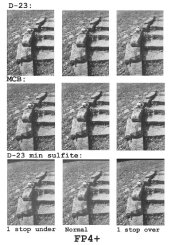OK - I'm a bit slow, but Patrick has made a good point (as usual

). Metol can be rejuvenated by ascorbate but only protected from its degradation products by sulfite. Therefore one would expect to be able to use far less metol in a developer if one switched from sulfite to ascorbate or AA.
The thread was about a slow acting D23 derivative much like a Beutler high dilution developer. Pat's times are way less than the 16 mins. of the D23/7 proposed by Dan.
Could it be that by using AA or ascorbate the metol could be reduced even more? It would result in a stand type developer with, say, half or a quarter of the metol and allowed to work for the 16 mins of the original post? I am used to 20-30 mins. regularly, to enhance the edge effect. I use slow films mostly and they respond to stand development better than 400ISO films. I don't even have any 400 here.
Could it be that the iodide additive as in FX-1 would be beneficial if you wanted to take all the troubles of using tripod and fine lenses to achieve this end?
Questions, questions. I know - suck it and see.
Patrick has pointed out elsewhere that ascorbate doesn't develop in the pH range of borax so it is only a rejuvenator here. At what pH does the superaditivity cut in? This thread has posed more questions in my mind than usual and I thank one and all for the ideas expressed.
Pat has gone to a lot of trouble to make his point about substituting ascorbate for sulfite with his test strips but maybe we're wandering off the original theme of D23 at dilution acting like a Beutler developer. I would have thought that, perhaps, that was kinda obvious, if one looks at the composition of the final product.
I am encouraged to run the next EFKE 50 thru a way weaker metol brew with AA using a stand development process. I acknowledge Patrick doesn't subscribe stand development but I like to see things that maybe aren't there! Hicks's Law?

Food for thought.
Good night and thanks for the thread.
Murray










 ). Metol can be rejuvenated by ascorbate but only protected from its degradation products by sulfite. Therefore one would expect to be able to use far less metol in a developer if one switched from sulfite to ascorbate or AA.
). Metol can be rejuvenated by ascorbate but only protected from its degradation products by sulfite. Therefore one would expect to be able to use far less metol in a developer if one switched from sulfite to ascorbate or AA.

